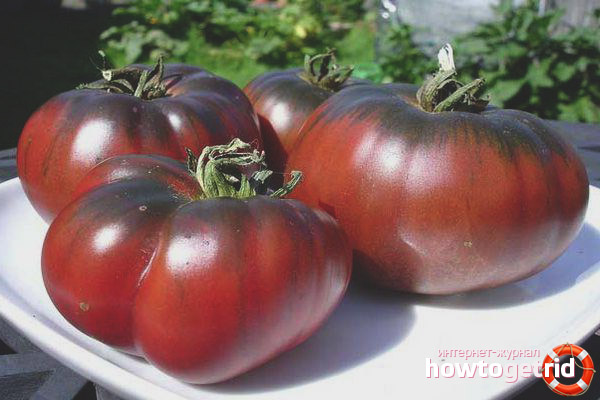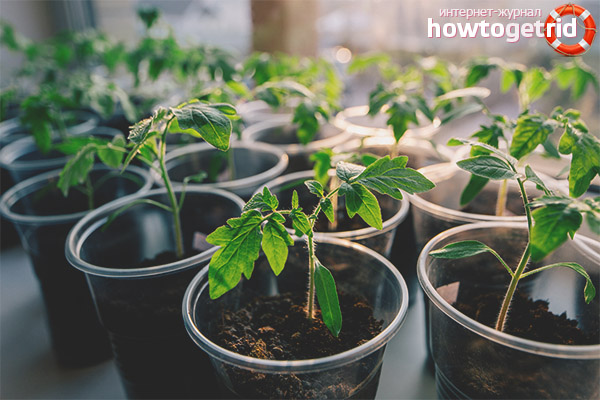The content of the article
Ebony - a variety of aronia. By color, the fruits are closer to brown than to black. Exotic tomatoes are grown in the same way as regular ones.
Grade characteristics
The peculiarity of the variety is its color - it is chocolate, which they achieve only with absolute maturity. You need to try to ensure that the fruits are tied in time.
The manufacturer gives such a characteristic:
- This is a mid-season variety, from the first sprouts to ripe fruits, it takes from 110 to 115 days.
- The variety can be grown in an open place and in greenhouse conditions.
- This species is resistant to various diseases, such as: alternariosis, leaf spot, cladosporiosis, tobacco mosaic virus.
- Tomato growth is not limited. During the growing season reaches a height of 1.5-2 m, so be sure to tie it up. In addition, lateral shoots need to be removed on time and a bush formed.
- The leaves of the plant are ordinary, green, dark in color, corrugated. The initial ovary occurs at the level of 9-12 sheets, then the brushes will appear after 3 sheets.
- Harvest with sq. m with 3-4 bushes is small - about 6.5 kg.
- Tomato fruits weigh from 100 to 160 g.
- Berries with a flat round shape with a ribbed base.
- When fully ripened, the fruits acquire a brownish color. The pulp is dense, but juicy, soft. Fruits with excellent taste, sweet, have a slight acidity.
- Tomatoes are quite suitable for canning, juices, pastes.
If you harvest an immature crop, it will ripen well at home and retain all qualities for up to a month and a half. According to summer residents, tomatoes have a fresh taste. Many note that, despite the low productivity, the Negritenok variety is worth planting.
Growing and caring for exotic tomatoes
The necessary measures should be taken to grow strong and healthy seedlings.
Growing seedlings
The soil needs to be prepared in advance. The substrate should absorb moisture well, not let air in, be treated for diseases. The earth needs to be warmed up at a temperature from 80 to 90 degrees, to make fertilizers. 60-65 days before planting a tomato, seeds need to be planted in seedlings. When preparing seeds, they need to be treated with a potassium permanganate solution and kept in a growth activator. If a tomato is grown in a greenhouse, then seeds for seedlings need to be planted in the first half of March. For open land, the second decade of March is suitable.
For seedlings, temperature balance and intense lighting are important. For germinating seeds, a temperature of 23-25 degrees is required. When the first sprouts appear, the temperature is lowered in the daytime to 12-15 degrees, and at night - to 8-10. After the appearance of 2 permanent leaves, the sprouts dive into separate containers. After this, plants need constant care: top dressing, watering and loosening. Watering should be moderate, feeding once every 2-3 weeks. Fertilizers need to be selected for each seedling individually, it all depends on the state of the sprouts.
A feature of the indeterminate variety is "stretching." To avoid this, it is necessary to observe the temperature regime: at night - 10-12 degrees, during the day in the sun - 20-25 degrees, in the absence of the sun - 15-18 degrees.
When flowering, boric acid is treated with stems and foliage. When spraying, the effect of a growth activator appears. The solution is made from 1 liter of water with 1 gram of boric acid. Spray in the evenings.
Planting plants
Planting of sprouts in the greenhouse takes place on the 10th of May, in open soil - from mid-May to early June. Landing takes place according to the scheme 60 to 40, or 3-4 bushes per sq.m. Density must be calculated from how many stems are planned for plant formation.
After the seedlings have taken root, it is necessary to fertilize and tie up the plant. Further care for tomatoes is standard: weeding, regular watering, loosening, removal of processes and dead leaves from the bottom.
Growing tomatoes takes 1-2 stems. An escape shoot emerges from the stepson under the first brush. Leaves from below need to be removed. Stepsons must be removed regularly, as the shoots that appear can take food from the main stem. The top point 3-4 weeks before the last harvest you need to pinch, leaving 3-4 sheets over the final brush.
Note! The fruits ripen in stages. The largest and earliest tomatoes form on the lower two hands.
This variety is resistant to known diseases. From many reviews of those who planted this variety, it follows that the Negro is the only one who grew up in greenhouse conditions, having survived the vagaries of nature and was not ill.
Further care recommendations are standard: moderate watering, feeding the roots, loosening the soil. To appreciate all the pros and cons of the Negritenok variety, you must definitely plant it in your own area.
Video: Negro Tomatoes











Submit